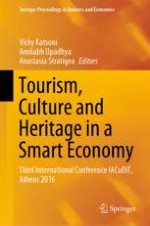2017 | OriginalPaper | Buchkapitel
A Hashtag Campaign: A Critical Tool to Transmedia Storytelling Within a Digital Strategy and Its Legal Informatics Issues. A Case Study
verfasst von : Anna Paola Paiano, Giuseppina Passiante, Lara Valente, Marco Mancarella
Erschienen in: Tourism, Culture and Heritage in a Smart Economy
Aktivieren Sie unsere intelligente Suche, um passende Fachinhalte oder Patente zu finden.
Wählen Sie Textabschnitte aus um mit Künstlicher Intelligenz passenden Patente zu finden. powered by
Markieren Sie Textabschnitte, um KI-gestützt weitere passende Inhalte zu finden. powered by
